╔
Dedicated to those who will come after us…
The ancient Venetians invented, day after day, their life and their city; those of today live from their city as from an inherited asset, using it in the easiest and least inventive way: in other words, they risk consuming it. If they continue to use Venice as an object to show on certain occasions, they will lose it as a living and therefore civilly expressive organism to have in exchange a restored, inert and embalmed monument, concluded in its form of tourist ruin, which will be exactly the opposite of Venice.
Giuseppe Mazzariol, in Louis Kahn. Un progetto per Venezia. Lotus n.6, 1969
Dedicato a chi verrà dopo di noi…
I Veneziani antichi inventavano, giorno dietro giorno, la loro vita e la loro città; quelli odierni vivono della loro città come di un bene ereditato, adoperandolo nella maniera più facile e meno inventiva: in altri termini rischiano di consumarlo. Se continueranno ad usare Venezia come un oggetto da mostrare in determinate occasioni, la perderanno come organismo vivente e quindi civilmente espressivo per avere in cambio un monumento restaurato, inerte e imbalsamato, concluso nella sua forma di rudere turistico, che sarà esattamente il contrario di Venezia.
Giuseppe Mazzariol, in Louis Kahn. Un progetto per Venezia. Lotus n.6, 1969
A book (and an exhibition), but above all a thought, an unpublished vision of the most photographed city in the world: all this is Venezia. Alter mundus, the work of Alessandra Chemollo, published by Marsilio Arte in 2022: another world, timeless, but which, at the same time, belongs to Time with a capital letter. A research that wants to transport the observer into a liquid dimension, into an eternal space, where are the stones, the architectures, the buildings, stripped of its inhabitants and of the sound of its visitors, to tell the story. Telling a human and, at the same time, a fantastic story, which has allowed man, a community, to first imagine, and then realize, a dream on water, testimony of its past history but also a warning for the future. A story of absolute beauty that finds, in the quotation of extraordinary relevance, taken from the essay by the Venetian art historian Giuseppe Mazzariol in 1969, its raison d’être and its warning for the next generations. A premonition which Chemollo has chosen to refer to, to remember that Venice, in its fragility, was and will be in spite of us, after us. But Franco Rella, in the essay entitled Imagining Venice that accompanies the volume, seems to suggest that Alessandra Chemollo’s Venice resists, despite everything, because it is invested with a task, that of “witness to beauty. Not just its beauty, but I would platonically say the beauty in and of itself”.
In the narrative sequence of images, Alessandra Chemollo does not ask for comments, does not seek explanations but makes explicit the very essence of the city, its consistency, shows it as it is, naked but deep and stratified, enhancing its characteristic of being another place, of belonging to a world with other rules and languages, without defined borders but full of contaminations, crossings, overlaps as its story tells. Here, then, history becomes canvas, painting, architecture.
As Franco Rella observes «the images that Alessandra Chemollo has traced and put into a plot, into a story, arise from a genuine attempt to go in search of another world, alter mundus. To do this, she has not only followed the profiles of the magnificent buildings, monuments and houses she presents to us; she has not only chased the water in which the columns sink or are reflected, but she has tried to empty Venice of everything that constitutes it today, but that above all masks it. His Venice has no pigeons, no seagulls, no tourists ».
However, in these images, the human presence, albeit marginal and reduced to a minimum, is a reminder that urban space is always in relationship with its inhabitants, and that Venice preserves, in both terms of scale and functions, the dialogue between natural environment and architecture, the balance between intimacy and universality that still today welcomes and contains. Indeed, it is our gaze, our belonging to that narration, our daily emotion in inhabiting it, in enjoying it, that makes those stones and that water a miracle that still leaves us breathless today.
Un libro (e una mostra), ma soprattutto un pensiero, una visione inedita sulla città più fotografata al mondo: tutto questo è Venezia alter mundus, il lavoro di Alessandra Chemollo, edito da Marsilio Arte nel 2022: un mondo altro, diverso, senza tempo, ma che, al tempo stesso, appartiene al Tempo con la maiuscola. Una ricerca che vuole trasportare l’osservatore in una dimensione liquida, in uno spazio a-temporale, dove sono le pietre, le architetture, gli edifici, spogliati dei suoi abitanti e del suono dei suoi visitatori, a raccontare. A dire una storia umana e fantastica al tempo stesso, che ha permesso all’uomo, a una comunità, di immaginare prima, e realizzare poi, un sogno sull’acqua, testimonianza della sua storia passata ma anche un monito per il futuro. Una storia di bellezza assoluta che trova, nella citazione tratta dal saggio dello storico dell’arte veneziano Giuseppe Mazzariol nel 1969, di straordinaria attualità, la sua ragion d’essere e il suo ammonimento per le prossime generazioni. Una premonizione cui Chemollo ha scelto di riferirsi, per ricordare che Venezia, nella sua fragilità, c’era e ci sarà a dispetto di noi, dopo di noi. Ma Franco Rella, nel saggio dal titolo “Immaginare Venezia” che accompagna il volume, sembra suggerire che la Venezia di Alessandra Chemollo resista, a dispetto di tutto, perché investita di un compito, quello di “testimoniare la bellezza. Non solo la sua bellezza, ma direi platonicamente la bellezza in sé e per sé”.
Nella sequenza di fotografie, Alessandra Chemollo non chiede commenti, non cerca spiegazioni ma esplicita l’essenza stessa della città, la sua consistenza, la mostra così com’è, nuda ma profonda e stratificata, esaltandone la caratteristica di essere un luogo altro, di appartenere ad un mondo con altre regole e linguaggi, senza confini definiti ma ricco di contaminazioni, sconfinamenti, sovrapposizioni come la sua storia racconta. Ecco, quindi, che la storia si fa tela, si fa quadro, si fa architettura.
Come osserva Rella, «le immagini che Alessandra Chemollo ha tracciato e ha messo in una trama, in una storia, nascono dal tentativo davvero di andare alla ricerca di un mondo altro, alter mundus. Per fare questo non ha soltanto seguito i profili delle stupende costruzioni, dei monumenti e delle case che ci presenta; non ha solo inseguito l’acqua in cui affondano o si riflettono le colonne, ma ha cercato di svuotare Venezia da tutto ciò che oggi la costituisce ma che soprattutto la maschera. La sua Venezia non ha piccioni, non ha gabbiani, non ha turisti».
In queste immagini però, la presenza umana, pur marginale e ridotta al minimo, sta a ricordare che lo spazio urbano è sempre in relazione con chi lo abita, e che Venezia conserva, sia nella scala che nelle funzioni, quel dialogo tra ambiente naturale e architettura, quell’equilibrio tra intimità e universalità che ancora oggi accoglie e contiene. È infatti il nostro sguardo, il nostro appartenere a quella narrazione, la nostra emozione quotidiana nell’abitarla, nel goderne, a rendere quelle pietre e quell’acqua un miracolo che ancora oggi lascia senza fiato.
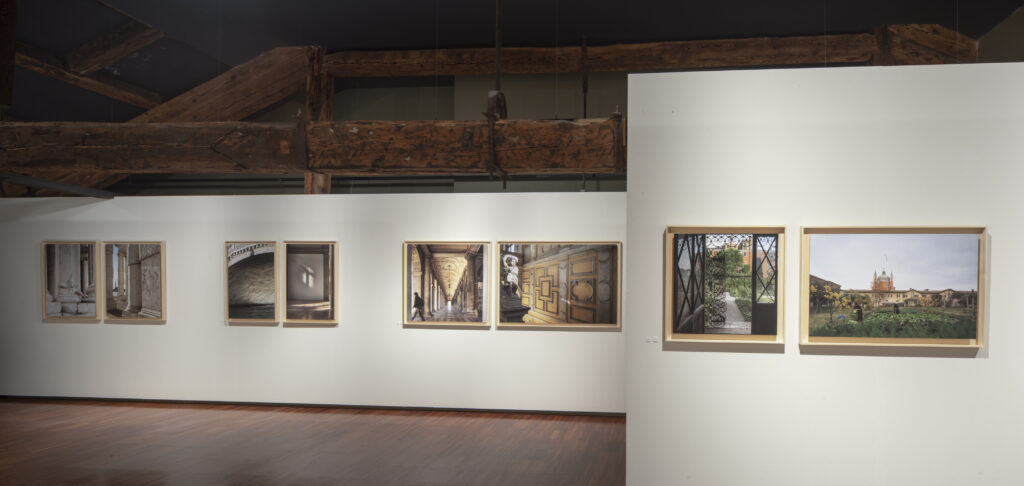
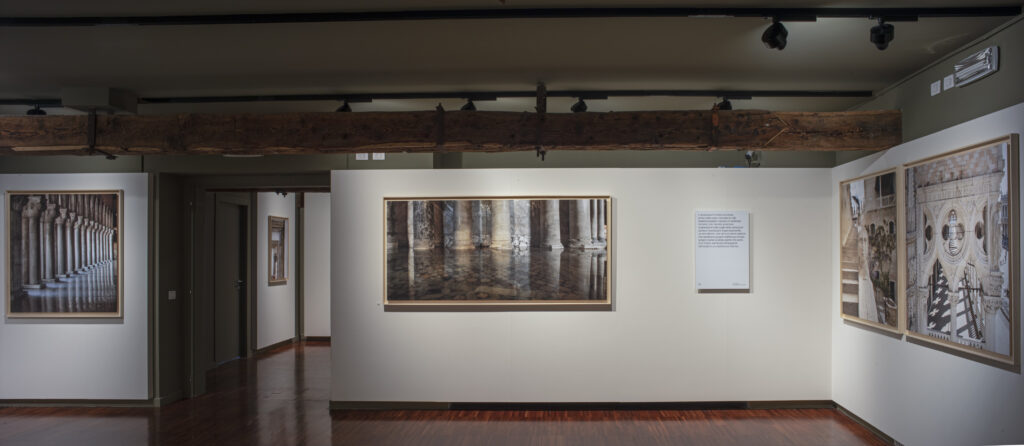
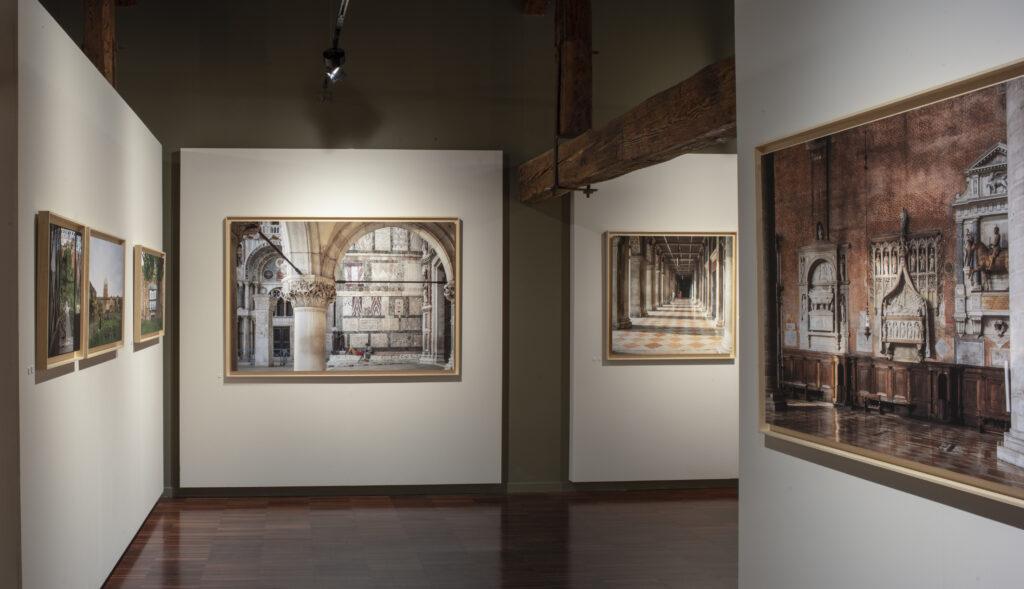
The setting up of Alessandra Chemollo’s exhibition “Veniezia. Alter mundus” at Le Stanze della Fotografia, the new space dedicated to photography on the Island of San Giorgio (Venice, 28 April – 4 June 2023).
L’allestimento della mostra di Alessandra Chemollo “Venezia. Alter mundus” presso Le Stanze della Fotografia, il nuovo spazio dedicato alla fotografia all’Isola di San Giorgio (28 aprile – 4 giugno 2023).
The word to the Authors
La parola agli Autori
Marta MORETTI – You have chosen to tell a monumental Venice, but which bears the traces of the stratifications of history. Do you think this is the task of architecture? That of being a testimony that remains despite the passage of time?
Alessandra CHEMOLLO – I believe that architecture is above all a representation that should be read from time distance. To carry out this work, I nourished myself with readings, and I remarked how each era has given a different interpretation of Venice: the ones given in the 16th century, when the city was at its maximum splendour, are characterized by astonishment, amazement, and magnificence, while those given in the 18th century, when the city was defeated and wounded, are of a completely different sign. The central theme is precisely that of the distance with which things are read.
No one has grasped Venice better than Sergio Bettini, who represents a fundamental point of reference for me. In Venice. Birth of a city Bettini compares the representation of Venice to the ones of any classic city. While for the latter the reading of the city derives from perspective and space, Venice instead works on the level of colour, light and rhythm. In this sense, water plays a fundamental role by subverting the rules of statics and ignoring the rigid symmetries, keeping instead the balance between the unlimited surfaces of the water and the sky. In this sense, the facades of the palazzi no longer belong to the building itself but become cities in their reflection on the water.
Marta MORETTI – Hai scelto di raccontare una Venezia di pietra, monumentale, ma che porta le tracce delle stratificazioni della storia. Credi sia questo il compito dell’architettura? Quello di essere testimonianza che resta a dispetto del tempo?
Alessandra CHEMOLLO – Credo che l’architettura sia innanzitutto una rappresentazione che vada letta a distanza del tempo. Per realizzare questo lavoro, mi sono nutrita di letture, e ho rimarcato come ogni epoca abbia dato una lettura diversa di Venezia: le restituzioni date nel Cinquecento, quando la città era al suo massimo splendore, sono connotate da strabiliamento, stupore e magnificenza, mentre quelle date nel Settecento, quando la città era sconfitta e ferita, sono di tutt’altro segno. Il tema centrale è proprio quello della distanza con cui si leggono le cose.
Nessuno meglio di Sergio Bettini, che rappresenta per me un punto di riferimento fondamentale, ha colto in Venezia. Nascita di una città la differenza nella rappresentazione di Venezia rispetto a qualsiasi città classica. Mentre per queste ultime la lettura della città deriva dalla prospettiva e dallo spazio, Venezia invece lavora sul piano del colore, della luce e del ritmo. L’acqua in questo senso gioca un ruolo fondamentale sovvertendo le regole della statica e ignorando le rigide simmetrie, tenendosi invece in bilico tra le superfici illimitate dell’acqua e del cielo. In questo senso, le stesse facciate dei palazzi non appartengono più all’edificio in sé ma diventano città nel loro specchiarsi sull’acqua.

Basilica of Saints John and Paul, interior towards the convent (Alessandra Chemollo, @Patriarchate of Venice, 2022).
Basilica dei Santi Giovanni e Paolo, interno verso il convento (Alessandra Chemollo, @Patriarcato di Venezia, 2022).
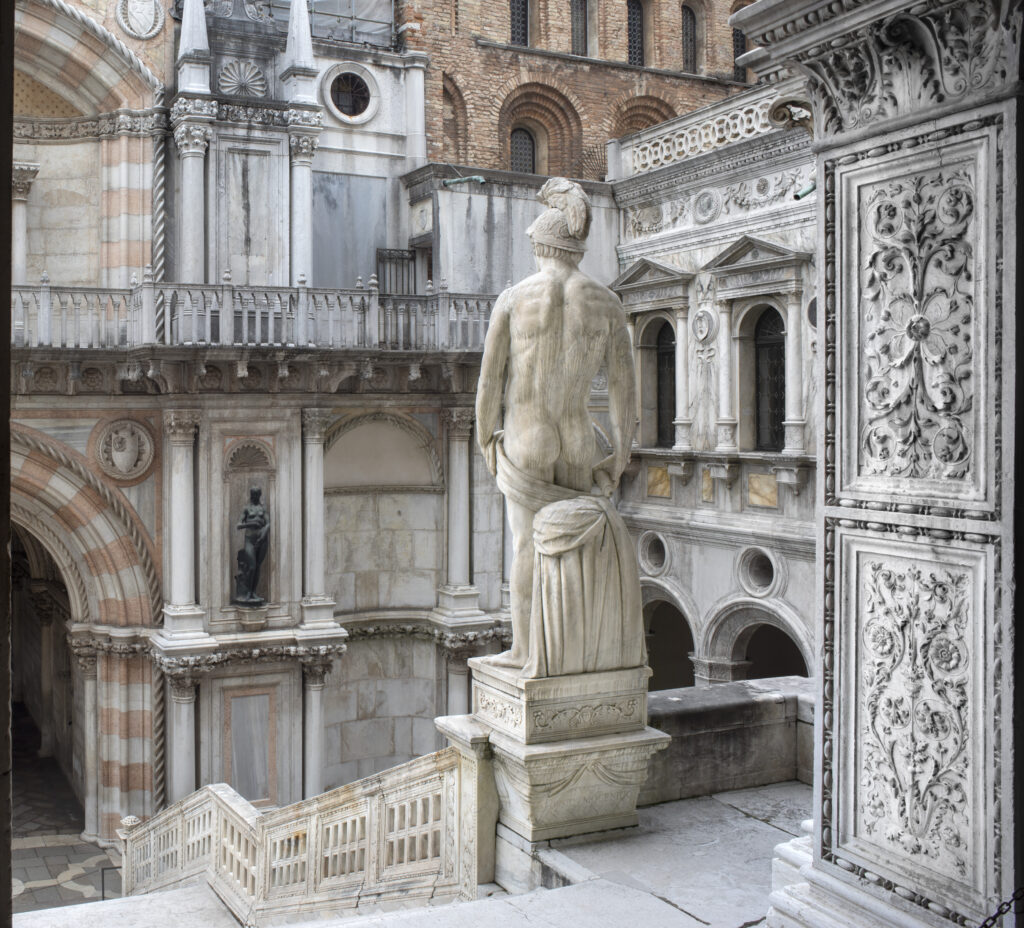
Doge’s Palace, Staircase of the Giants (Alessandra Chemollo, @Fondazione Musei Civici 2022).
Palazzo Ducale, Scala dei Giganti (Alessandra Chemollo, @Fondazione Musei Civici 2022).
In your images the pure beauty of Venice emerges, its forms and its architectures, invented by man, but where man is marginal, he disappears. As if man had fulfilled his maximum function in building the city and was today secondary with respect to the permanence of its structure. Is that so?
This is also Bettini’s fundamental question. What makes Venice Venice? How did the Venetians of the past imagine it? What was the artistic intention he has built such an anomalous urban structure? My work intended to enhance this aspect in particular, and bring out the overall work of art, produced over time by an entire community that has organized and recognized itself in this space.
Nelle tue immagini emerge la bellezza di Venezia allo stato puro, le sue forme e le sue architetture, inventate dall’uomo, ma dove l’uomo è marginale, scompare. Come se l’uomo avesse assolto la sua massima funzione nel costruire la città, e fosse oggi ‘marginale’ rispetto alla permanenza della sua struttura. E’ così?
Questo anche è il quesito fondamentale di Bettini. Che cosa fa di Venezia Venezia? Come hanno fatto i veneziani del passato ad immaginarsela? Quale è stata l’intenzione artistica che ha costruito una struttura urbana così anomala? Il mio lavoro intendeva valorizzare in particolare questo aspetto, e far emergere l’opera d’arte complessiva, prodotta nel corso del tempo da una intera comunità che si è organizzata e riconosciuta in questo spazio.
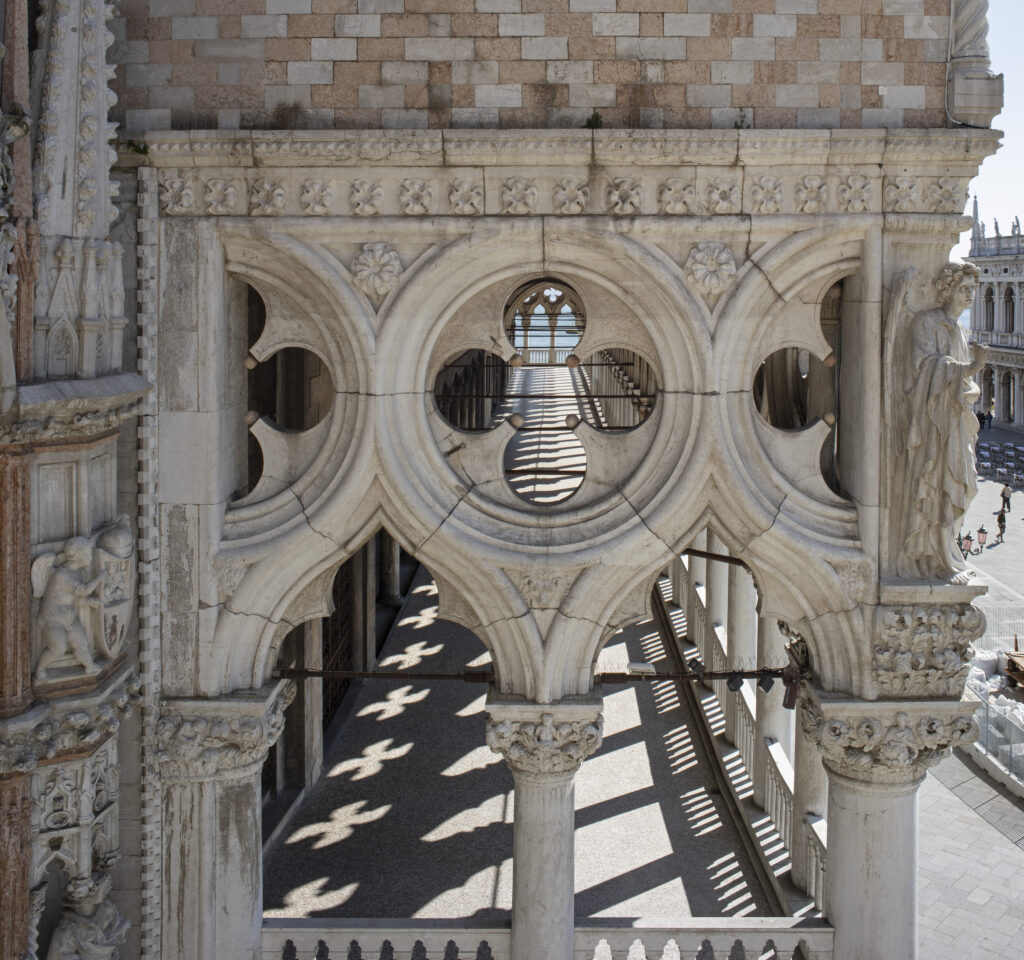
Palazzo Ducale, Loggia Foscara seen from the Basilica of San Marco, homage to Fulvio Roiter Venise a fleur d’eau (Alessandra Chemollo, @Soprintendenza Archaeology, Fine Arts and Landscape for the Municipality of Venice and Laguna, 2022).
Palazzo Ducale, Loggia Foscara vista dalla Basilica di San Marco, omaggio a Fulvio Roiter Venise a fleur d’eau (Alessandra Chemollo, @Soprintendenza Archeologia, Belle Arti e Paesaggio per il Comune di Venezia e Laguna, 2022).
As Franco Rella observed in his essay entitled Imagining Venice, you have emptied “Venice of everything that constitutes it today but above all the mask”. It almost seems as if you have distanced yourself from the questions that ignite the debate on the future of the city and that you instead accompany the observer into a total aesthetic dimension in which to immerse yourself, traveling above the controversies.
Beauty in many ways is salvific. I have tried to highlight the strength of this beauty, not as nostalgia for the past but as an element that allows us to defend its future. I wanted to restore the extraordinary diversity of Venice which, as such, must be protected and preserved. I am very grateful to Marsilio Arte and, in particular to the editor Rossella Martignoni, because in this volume we have managed to create together a sequence of images similar to an emotional narration, with a rare coincidence of intents.
Come ha osservato Franco Rella nel suo saggio dal titolo “Immaginare Venezia”, hai svuotato “Venezia da tutto ciò che oggi la costituisce ma che soprattutto la maschera”. Sembra quasi che tu ti sia allontanata dalle questioni che accendono il dibattito sul futuro della città e che tu accompagni invece l’osservatore in una dimensione estetica totale in cui immergersi, viaggiando al di sopra delle polemiche.
La bellezza in molti sensi è salvifica. Io ho cercato di mettere in luce la forza di questa bellezza, non come nostalgia del passato ma come elemento che ci permette di difendere il suo futuro. Volevo restituire la straordinaria diversità di Venezia che, in quanto tale, va protetta e preservata. Sono molto grata a Marsilio Arte e, in particolare all’editor Rossella Martignoni, perché in questo volume siamo riusciti a realizzare insieme una sequenza di immagini simili ad una narrazione emotiva, con una rara coincidenza di intenti.
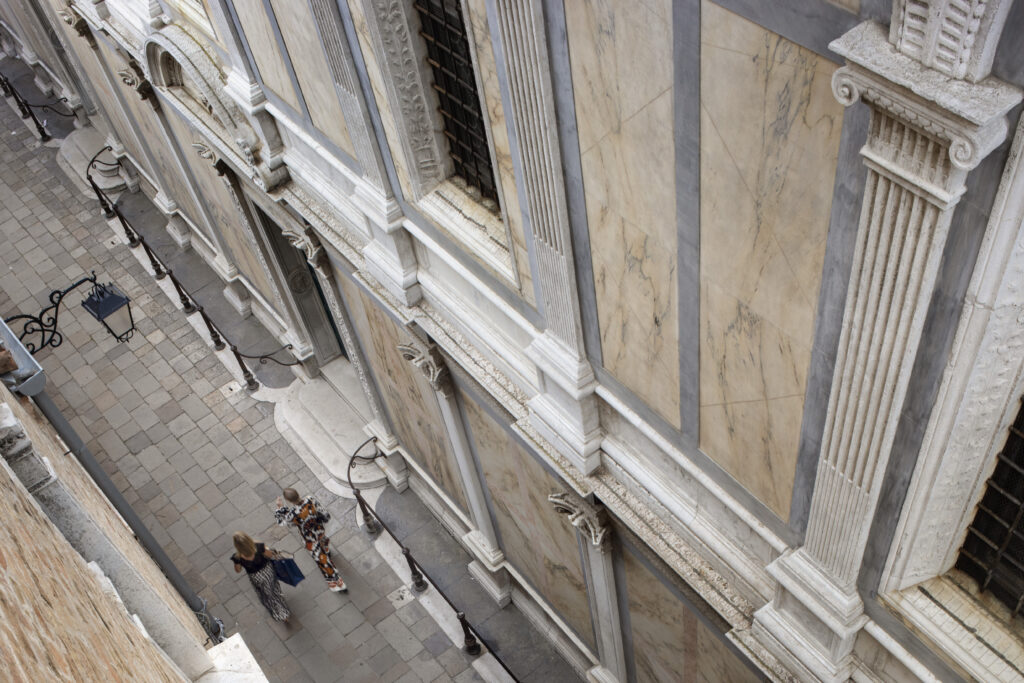
Church of Santa Maria dei Miracoli, seen from Palazzo Van Axel (Alessandra Chemollo, 2022).
Chiesa di Santa Maria dei Miracoli, vista da Palazzo Van Axel (Alessandra Chemollo, 2022).
Did the experience of Covid and the silence in the city play a part in your gaze?
A minimal part of the images in this collection were taken during the lockdown period because I didn’t want to miss the unrepeatable opportunity to memorize and record the “liberation” of the city. The first image from early March 2020 is that of Campo San Polo and, fortunately in that period, I was among those who, thanks to my work, were able to move and feel the silence but also the strength of the empty city.
L’esperienza del Covid e del silenzio in città ha avuto una qualche parte nel tuo sguardo?
Una minima parte delle immagini in questa raccolta sono state realizzate nel periodo del lockdown perché non ho voluto perdere l’occasione irripetibile di poter memorizzare e fissare la “liberazione” della città. La prima immagine dei primi di marzo del 2020 è quella di campo San Polo e, per fortuna in quel periodo, sono stata tra coloro i quali, proprio grazie al mio lavoro, hanno potuto muovermi e sentire il silenzio ma anche la forza della città vuota.

Campo Santa Giustina (Alessandra Chemollo, 2020).
Campo Santa Giustina (Alessandra Chemollo, 2020).
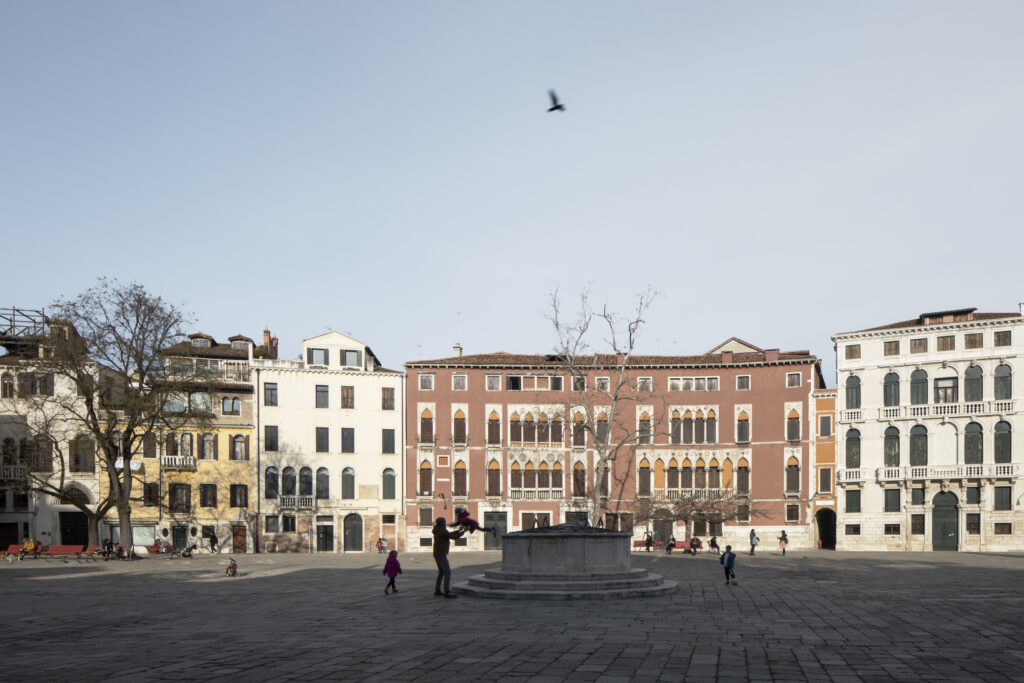
Campo San Polo (Alessandra Chemollo, 2020).
Campo San Polo (Alessandra Chemollo, 2020).
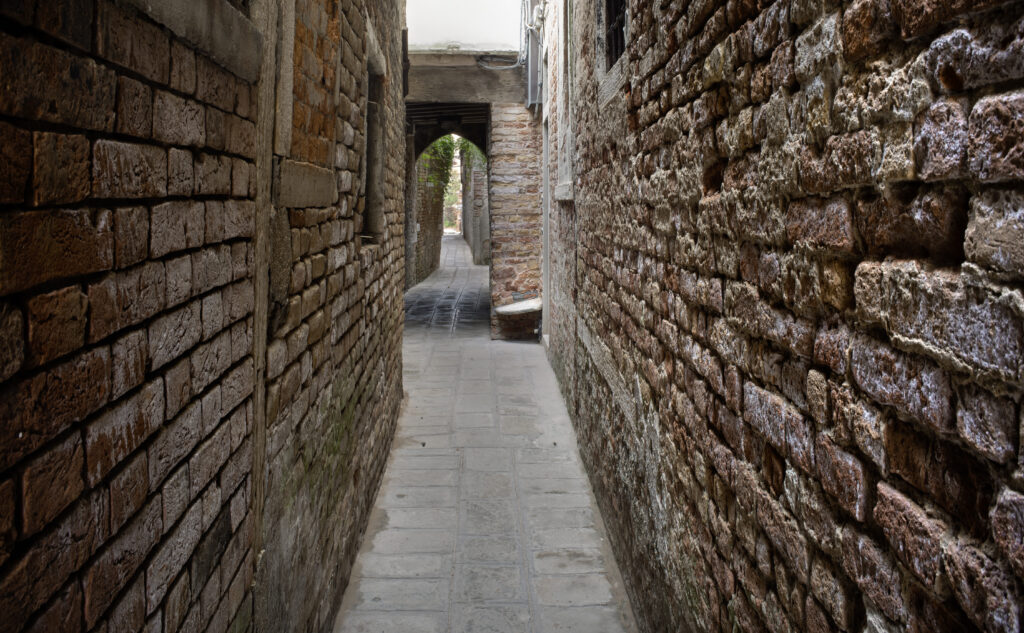
Calle Zoccolo, Cannaregio (Alessandra Chemollo, 20220).
Calle Zoccolo, Cannaregio (Alessandra Chemollo, 2020).
BOOK Info
Alessandra Chemollo
Venezia. Alter mundus
with an essay by Franco Rella
Marsilio Arte; 2022
ISBN: 979-12-5463-016-7
Authors’ Biographies
Alessandra CHEMOLLO
She graduated from the IUAV University, with a thesis on the relationship between architecture and photography. She created photographic projects to illustrate numerous volumes, deepening specific ways of reading the architectural work starting from documentary assumptions. In her thirty years of professional experience, she ranges from historical to contemporary architecture and develops theoretical fields with didactic and curatorial purposes.
Franco RELLA (with an essay by)
Philosopher and essayist, he taught Aesthetics at the IUAV in Venice for years. He interpreted the discipline as a frontier and place of exchange between art and philosophy, moving in both territories. For Feltrinelli he is the author of numerous essays on art, literature and philosophy.